Via Romea Germanica X
Salorno, Italy to (near) Nave San Felice
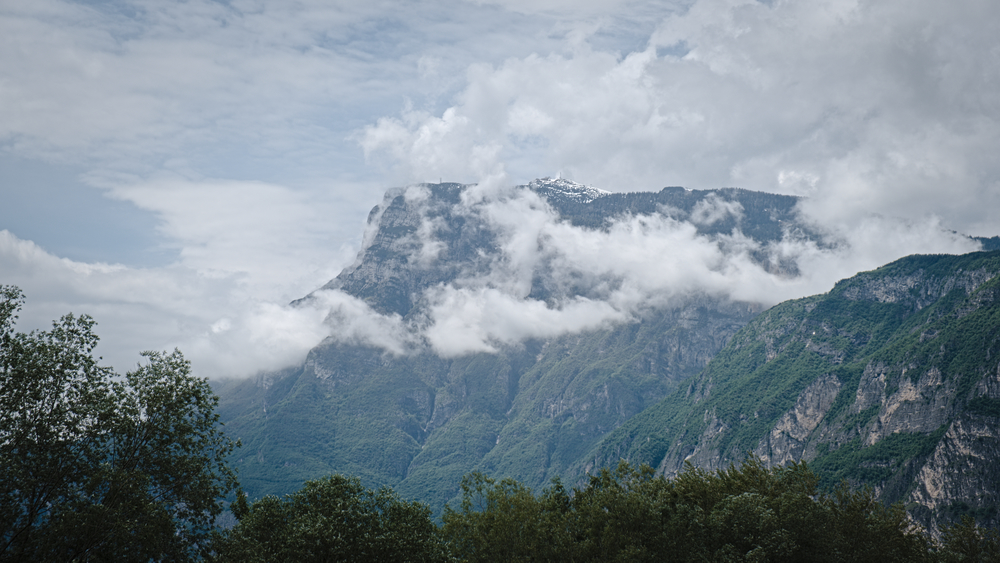
We have yet to leave the mountains of the Alto Adige behind us.
7:55 AM. The cathedral bells of Salorno had been tolling vigorously for about five minutes, calling the faithful to the morning mass. Suddenly, we heard the sound of a brass band erupt outside our hotel. What was this? An unanticipated display of South Tyrolian culture? I threw on my shoes and scampered down two flights of stairs to the ground floor of our hotel.
Welcome to the Peripatetic Historian's multi-part series about hiking the Via Romea Germanica.
If you have stumbled across this installment by accident or a fortuitous Google search, and have no idea what is happening, you might prefer to begin at the start of the series, here: Introduction to the Via Romea Germanica
Otherwise, let's return to our story, already in progress.
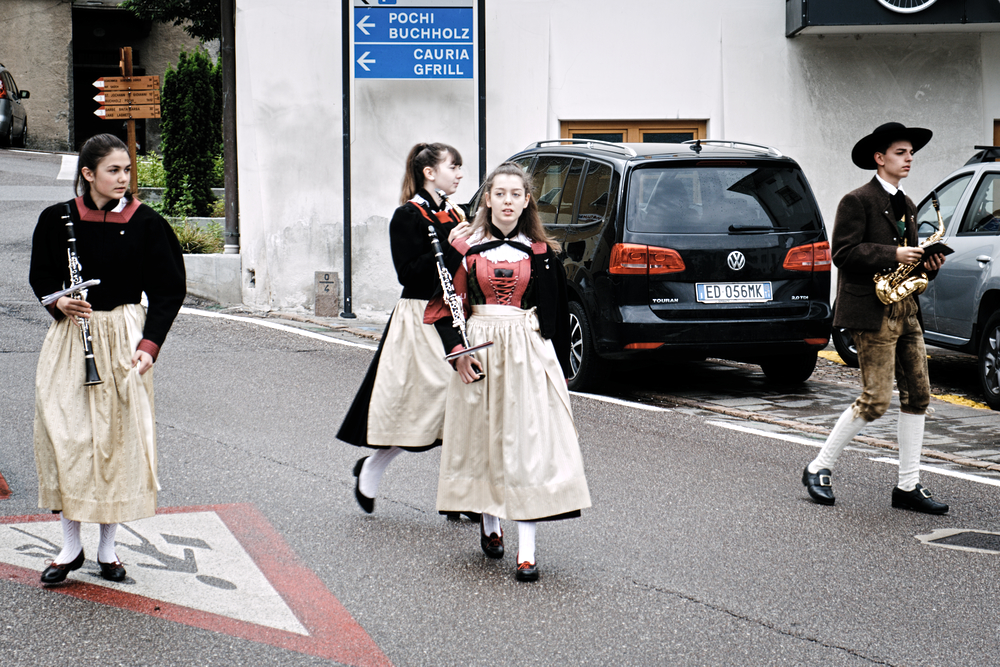
Younger members of the Salorno band.
Just as I made it to the Piazza Duomo, a large brass band finished their song and began to break formation. The players wore traditional dress: brown tunics and hats. Their ages spanned the generations, from teenage girls to old men with Gandalf beards. As the echo of the last brassy notes died in mountains, the well-dressed families that had been listening to the music climbed the steps and went into the cathedral. The band broke formation, milled around in the street, and then dispersed. Some went into town hall across the street, others trudged down to the bar at our hotel to order a morning espresso.
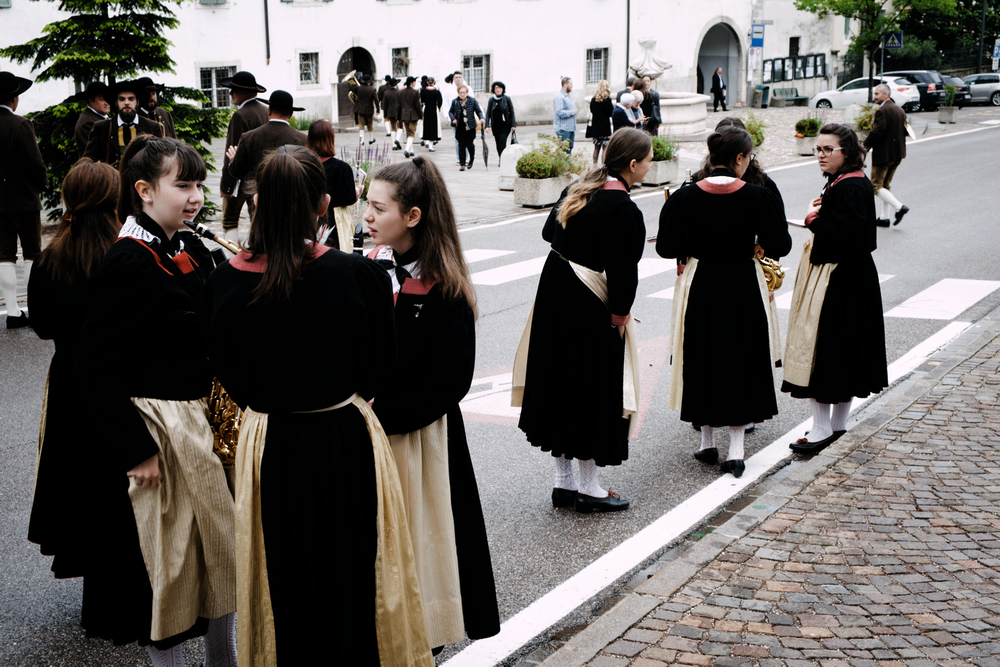
The band in repose.
It was strange, an inexplicable mystery. Does the band assemble every Sunday morning to serenade arriving parishioners, or was there something else behind this musical outburst?
Further investigation—the cutting edge journalism that readers of this series have come to expect—revealed that this was Salorno’s celebration of the rite of confirmation. Several of the local teenagers were being confirmed in the cathedral on Sunday morning, and this was the town’s way of commemorating that step of faith. A lovely custom.
The hour had arrived for us to hoist our packs and leave Salorno, a town that had been very nice to us. Rain had battered our windows in the middle of the night, but the monsoon had ceased by the time the band played. Time to move along, to put several kilometers beneath our feet before the raindrops returned.
Today's hike marked a major milestone: we would be leaving the Sud Tirol. We have spent ten days in this Germanic region of northern Italy, but this stage of our journey crosses the southern border and moves into the province of Trentino.
I had already noted some signs of the approaching transition. Last night, for example, I heard more Italian than German. To this point every street sign has been bilingual, with the German name on top. In Salorno, the Italian names are on top. Salorno/Salurn is the last town on our map with two names. From here to Rome, we will be in a monolingual environment.
We sauntered out of town and immediately turned onto the bike trail. Most of today’s stage will follow the bike trail, running flat and true beside the Adige river. Whoever said dreams don't come true?
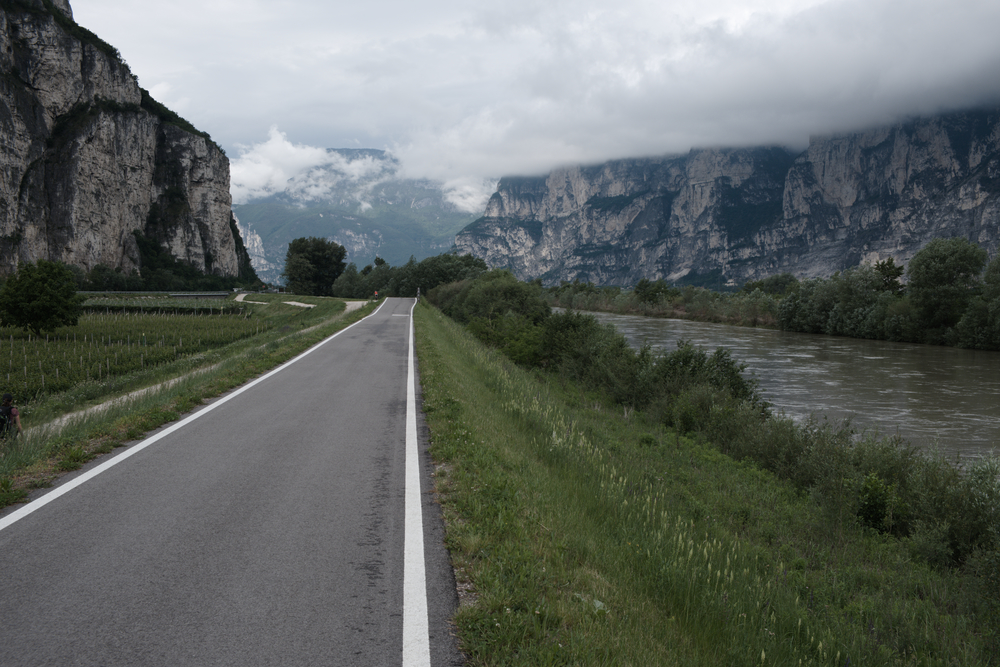
Straight, flat, and true: the glorious bike trail.
Roughly three kilometers south of Salorno, we crossed the border. A sign wished the motorists on the statale “arrivederci” from Sud Tirol, and then we were in Trentino.
As a practical matter, we elected to cut today’s stage in two. The guidebook calls for a 29.5 KM hike to Trento, with hills in the second half, but we have chosen to turn this into a two day hike.
There was only one small problem: food. We planned to stay at an agriturismo in the hills above Nave San Felice, but the town did not have a restaurant. In fact, restaurants are thin on the ground in this part of the country, and what few existed, were closed on Sundays. Mary had thought that we might at least pass a store where we could grab some food to tide us over, but there weren’t any stores either. As we approached Nave San Felice, we began to grow concerned.
The tiny town does have a hotel/restaurant, but according to Google, the restaurant was closed. Maybe, we thought, there would be an open bar near the hotel where we could get some basic supplies.
There wasn’t. When we pulled up in front of the hotel, it was dark. Mary pushed on the front door and it opened. Shadows cloaked the entryway. Something began to beep.
“It’s an alarm,” I muttered, half in jest. Why, after all, would the front door of a hotel have an alarm on it? Aren’t hotels always open?
A siren split the air. It was a burglar alarm. We walked around the end of the building as a teenage boy came flying by on his bicycle. “Sorry,” yelled Mary, as he passed.
We rounded a corner behind the hotel, following a sign for a pizzeria. A group of men swarmed out of a house into the street. “Via Romea?” asked one of the men.
“Si,” I replied.
“That way.” He pointed south, in the direction of Lavis. He was rather emphatic: we were off course and he wanted to set us right.
“No,” I explained in my my fractured and fractious Italian. “We are looking for a restaurant.”
“All closed on Sunday,” he said.
“How about a supermarket or store?”
“No. All closed.”
“We need to find some food.”
The men began one of those delightful Italian conversations in which they debated solutions to our plight in language that was much too fast for me to follow. Finally, one of the younger men pulled out his mobile phone and placed a call. He explained to the person on the other end that we were pellegrini, had come from Brenner on foot, and needed something to eat.
As he worked on the plan, I spoke with the older man, who also, as it turned out, was a former pilgrim. He was a veteran of the Camino Francese, Camino Portugese, and the Via della Plata in Spain. He was definitely sympathetic to our plight.
“Allora.” The man with the mobile phone hung up. “Follow this boy and he will take you where you can get food.”
That sounded good. We followed our young companion (the same teenage boy who had ridden his bike past us to turn off the hotel alarm — it turns out that his father had set the alarm but had forgotten to lock the hotel's front door. He accompanied us up a hill behind the town for a few minutes, and then stopped before a concrete path that angled steeply up into the forest.
“Walk maybe 300 meters up this path, and you will find a house. Go to the house, ring the doorbell, and someone will give you food.”
Okay.
Now, I have to confess that I had already formulated my own plan. There was a small train station in Nave San Felice. I thought we should hop on a train, ride into Trento, a large city that surely possessed restaurants doing business on a Sunday. We could grab a bite at a restaurant or a pizzeria, then ride the train back out to Nave San Felice and finish the last leg of our journey.
It was a good plan, a sensible plan. We decided to try the house on the hill first. Up we went, climbing away from the valley floor, far from my beloved bike path, on a small road that angled up at roughly a 45 degree angle. I studied my GPS, and the only thing it indicated was Maso Poli, which I assumed was a winery. Had our friends below called a winery on our behalf?
After a long slog, we came to the first (and only) house, which, as it happens, was Maso Poli. There was a tour bus in the parking lot, flanked by a pack of parked cars. Well-dressed Italians wandered among the vines, contemplating the subtleties of vintages and graftstock.
We approached the entrance. Another teenage boy met us. Could we get food here, we inquired?
“No, sorry,” he said, and then rattled something off in German.
“Could we speak English, or Italian?” I asked.
He seemed confused. My fractured Italian often has that effect on people. “Wait here,” he replied. A minute later he returned, dragging a lovely young lady who would turn out to be our guardian angel. The Angel of Maso Poli. I was able to initiate a mixed English/Italian dialogue with her. As it happened, Maso Poli was holding a wine-tasting event this afternoon. We could purchase tickets (ten euros each) that would allow us to sample a variety of wines, but more importantly, would give us access to the inner sanctum, behind the fence, where a catering service was cooking food that we could purchase.
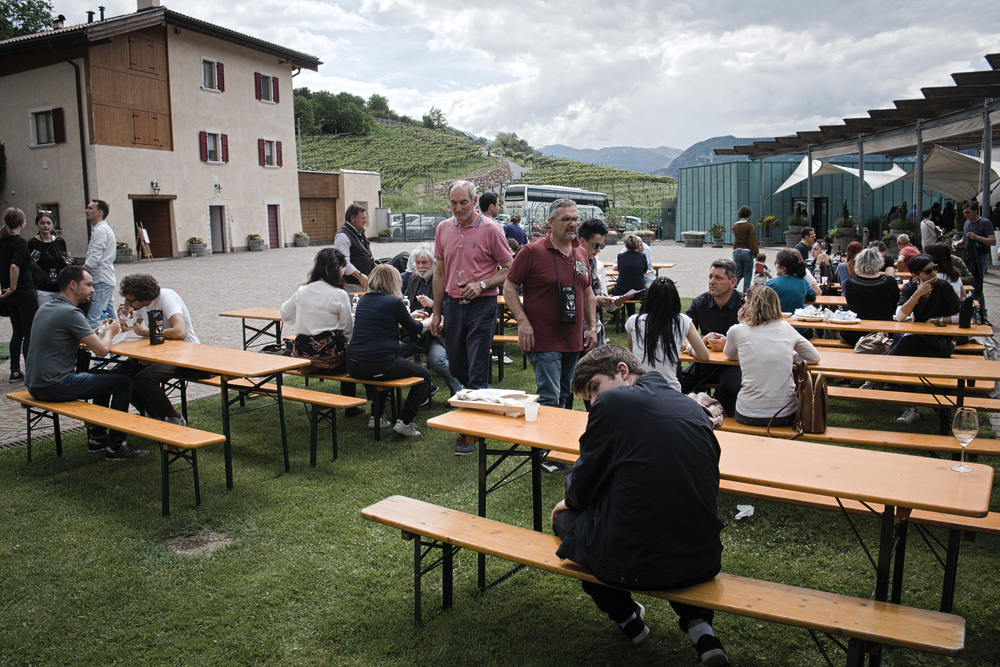
Sunday afternoon wine-tasting and food court at the Maso Poli winery.
We could also, if we desired, go on a guided tour of the vineyards.
Wine-tasting—check. Food—double-check. Vineyard tour? Maybe next time.
The Angel of Maso Poli found an out-of-the-way corner where we could stash our backpacks, and then she gave us both glasses and a half-bib, half-pouch contrivance to hang around our necks. This turned out to be a neck-mounted wine
glass holder. We looked like St Bernards carrying casks of ale. I still am not completely certain of its utility, but I suppose it made a handy place to stash a half-full wine glass while you expounded on the superior quality of the wine, freeing both hands to swoop and zoom like barn swallows in wild flights of ecstatic appreciation.
We tried a couple of samples, but, uncharacteristically, my heart wasn’t in it. I wanted what was at the other end of the compound: food. The cooks had set up a barbecue unit, and their sign promised “American Barbecue.” The already-served, chewing away at the tables, were tucking into barbecued ribs and pulled-pork sandwiches. Give me some of that protein now, I thought.
We took our place at the end of a line that stretched twenty people long. Thirty minutes later I estimated that there were still about fifteen people ahead of us. This was absolutely the slowest food truck I had ever seen. I think they were stalling, working slowly because they had run out of pork. After one of the cooks pulled a slab out of the barbecue unit, the line began to move more quickly.
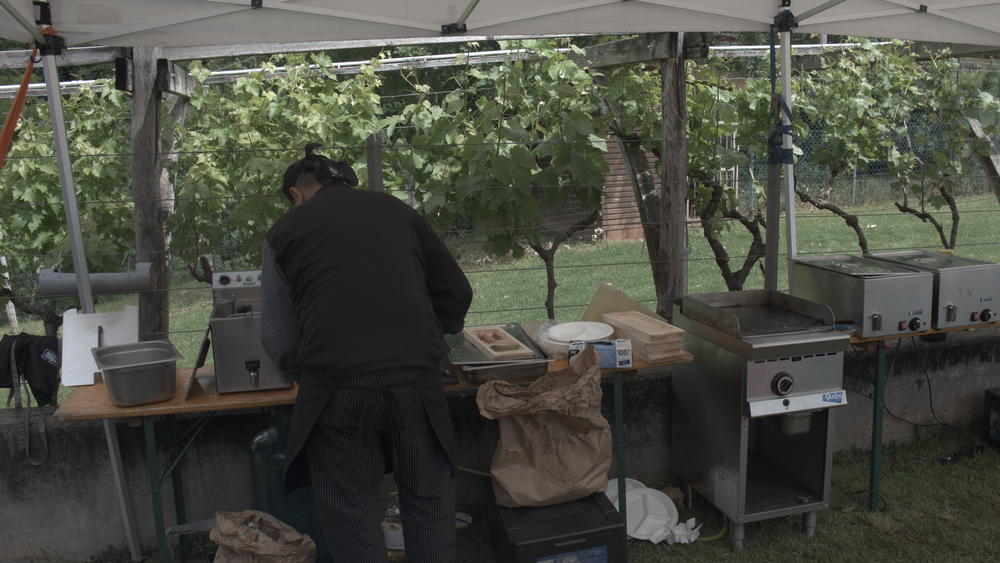
The purveyor of "Authentic American Barbecue."
Another oddity. After I had ordered my ribs, the cook sliced them, and then placed them on a lukewarm griddle. Hadn’t the barbecue unit already reduced the ribs into melt-in-the-mouth flesh? Why would you need more cooking time on a grill? When I finally sat down to eat, the ribs were still pretty tough, with the consistency of a medium pork chop. Pretty chewy for American barbecue. Mary had ordered the “vegetarian” plate, which turned out to be a pile of french fries and a half-plate of melted cheese.
But you know what? It is amazing what you will eat and feel happy about eating when you know there are no more opportunities for a meal until breakfast the next day. And in fact, these were definitely the best “American Style” pork ribs I had ever eaten in Italy.
After finishing our meal, we collected our backpacks, bid goodbye to the Angel of Maso Poli, and headed down the hill to our agriturismo. Sometimes you don’t hop on the certain train to Trento, but rather, you let serendipity take the lead. Climb the mountain and knock on the door of the first house you find there. Who knows what will happen?
Today's distance: 14.7 KM Total distance: 178.06 KM
If you are enjoying this series, why not subscribe to Richard's monthly newsletter, What's New in Old News? The Peripatetic Historian is on the road, roaming the world and compiling fresh adventures. Don't miss out. Click here to join the legions of above-average readers who have already subscribed.